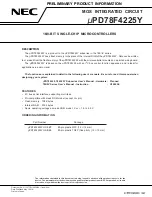Chapter 9 Pulse-Width Modulator (S12PWM8B8CV2)
S12ZVHY/S12ZVHL Family Reference Manual Rev. 1.05
Freescale Semiconductor
339
•
The channel is disabled
In this way, the output of the PWM will always be either the old duty waveform or the new duty waveform,
not some variation in between. If the channel is not enabled, then writes to the duty register will go directly
to the latches as well as the buffer.
NOTE
Reads of this register return the most recent value written. Reads do not
necessarily return the value of the currently active duty due to the double
buffering scheme.
Section 9.4.2.3, “PWM Period and Duty”
for more information.
NOTE
Depending on the polarity bit, the duty registers will contain the count of
either the high time or the low time. If the polarity bit is one, the output starts
high and then goes low when the duty count is reached, so the duty registers
contain a count of the high time. If the polarity bit is zero, the output starts
low and then goes high when the duty count is reached, so the duty registers
contain a count of the low time.
To calculate the output duty cycle (high time as a% of period) for a particular channel:
•
Polarity = 0 (PPOL x =0)
Duty Cycle = [(PWMPERx-PWMDTYx)/PWMPERx] * 100%
•
Polarity = 1 (PPOLx = 1)
Duty Cycle = [PWMDTYx / PWMPERx] * 100%
For boundary case programming values, please refer to
Section 9.4.2.8, “PWM Boundary Cases”
.
1
This register is available only when the corresponding channel exists and is reserved if that channel does not exist. Writes to
a reserved register have no functional effect. Reads from a reserved register return zeroes.
Read: Anytime
Write: Anytime
Module Base + 0x001C = PWMDTY0, 0x001D = PWMDTY1, 0x001E = PWMDTY2, 0x001F = PWMDTY3
Module Base + 0x0020 = PWMDTY4, 0x0021 = PWMDTY5, 0x0022 = PWMDTY6, 0x0023 = PWMDTY7
7
6
5
4
3
2
1
0
R
Bit 7
6
5
4
3
2
1
Bit 0
W
Reset
1
1
1
1
1
1
1
1
Figure 9-14. PWM Channel Duty Registers (PWMDTYx)


















